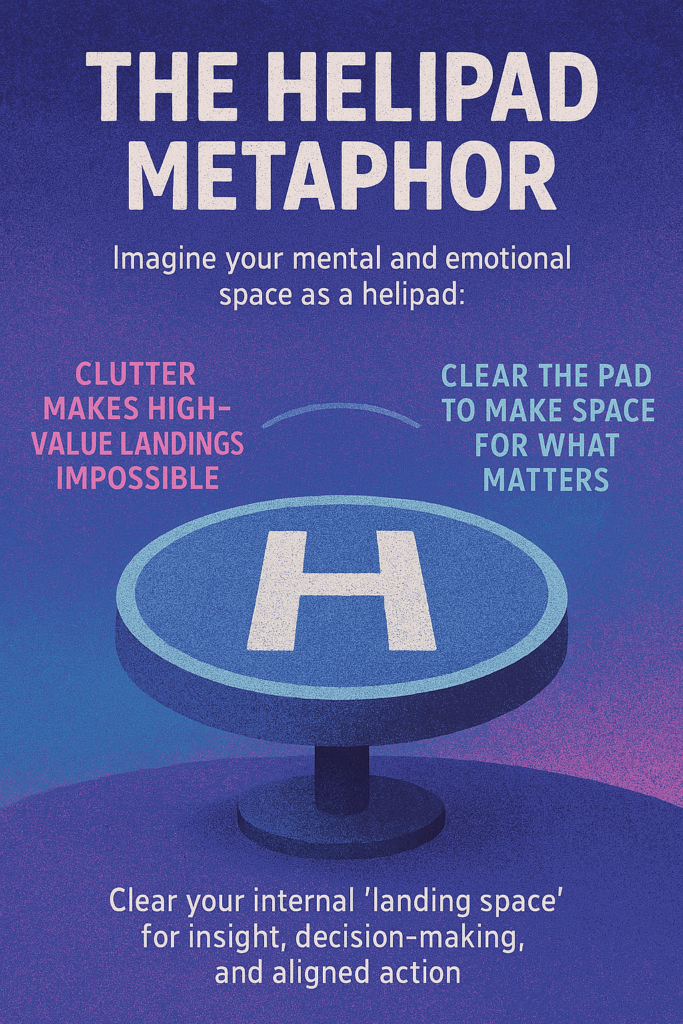An Insight for Leaders Navigating Complexity
The “Helipad” metaphor is a practical framework for understanding how attention, intention, and moral clarity intersect at the heart of generative leadership. It offers a precise lens to examine the inner conditions that determine whether strategic insight, purposeful action, and emotional balance can take flight—or remain grounded.
What is the Helipad?
Imagine your field of awareness—the dynamic space where perception, insight, and choice arise—as a helipad.

This helipad represents your available attention. It is a finite resource, constantly shaped by internal states and external demands. When the pad is clear, ideas can land. When it’s congested, nothing new—no breakthrough, no insight, no real choice—can enter.
Just as no helicopter can land safely on a cluttered surface, leadership decisions and aligned actions cannot take shape in an overwhelmed mental and emotional space.
Neuro-scientific studies have shown that attentional bandwidth is limited, and cognitive overload impairs executive functioning and decision-making capacity (Mark, Gudith, & Klocke, 2008). Maintaining clarity in the field of awareness enhances not only personal efficacy but also moral discernment and strategic responsiveness.
What Does It Represent?
- Your mental and emotional workspace
- The foundation for conscious focus and strategic engagement
- The alignment point of attention, intention, and moral clarity
- The gateway to discernment, responsibility, and generative presence
From an integral perspective, the helipad reflects a confluence of developmental lines—cognitive, emotional, ethical, and interpersonal. It is where state clarity, structural maturity, and intentional authorship meet. Harvard psychologist Robert Kegan’s theory of adult development supports this, showing that leadership effectiveness grows as individuals evolve through stages of meaning-making and relational complexity (Kegan & Lahey, 2009).
Using the Helipad in Practice
1. Identify What’s on the Pad
Start by observing what occupies your field of awareness:
- What’s consuming your mental and emotional bandwidth?
- What concerns, conflicts, or narratives are looping in the background?
- Are you carrying the weight of unresolved conversations, unspoken expectations, or unprocessed emotions?
This step requires self-awareness and the courage to acknowledge what’s present without justification or avoidance.
2. Clear the Pad
Clearing is not about suppression—it’s about restoration. It involves honouring what’s present, processing it, and making space.
Proven practices include:
- Reflective writing – To externalise inner dialogue and reclaim authorship
- Conscious compartmentalisation – To create space without spiritual bypass
- Radical self-honesty – To name what’s incomplete or misaligned
“Journaling gives me an ‘audience’. I’m both the speaker and the witness. That changes how the thought lives in me.”
Research affirms that expressive writing significantly reduces rumination and enhances psychological resilience by enabling meaning-making and emotional regulation (Pennebaker & Smyth, 2016).
3. Distinguish Between Rumination and Responsibility
Not everything unresolved demands action—but everything demands relationship.
Ask:
- What can I complete, communicate, or clarify?
- What must I accept or reframe?
- Where am I abdicating authorship or delaying what matters?
As Alan notes:
“Sometimes I didn’t say what I should’ve said. Or I packaged my expectations poorly.”
Owning our role—even in what feels incomplete—restores clarity and agency.
4. Make Space for High-Value Landings
Once cleared, your helipad becomes a fertile ground for new action:
- Strategic insight becomes accessible.
- Complex conversations can be approached with compassion and confidence.
- Moral clarity emerges—not as an abstraction, but as a lived orientation.
This is where intention can land. This is where generative leadership lives.
“When I clear space inside, I can land my vision and be the presence that leadership asks of me.”
Why It Matters
The helipad metaphor is more than a leadership tool—it’s an inner technology of presence.
It invites leaders to:
- Recognise clarity as a precondition for meaningful action
- Treat attention as a strategic asset
- Align moral clarity with practical decision-making
- Generate capacity by restoring coherence within
From an integral lens, the helipad metaphor integrates multiple perspectives:
- First-person: subjective awareness of one’s emotional and mental state
- Second-person: relational dynamics with others—unspoken expectations, withheld communications
- Third-person: objective structures—time management, priorities, unresolved logistics
- Fourth-person: the collective field and shared context in which leadership is enacted
- Fifth-person: the meta-systemic perspective of the leader as steward of evolving systems and conscious change
Integral theory teaches that mastery arises through the coordination of these perspectives. The helipad is where they converge. It is the locus of awareness, responsibility, and possibility—the inner space where vision becomes grounded and effective leadership becomes real.
In the end, a leader’s power lies not in the number of helicopters waiting—but in their readiness to land what truly matters.
References
Mark, G., Gudith, D., & Klocke, U. (2008). The cost of interrupted work: More speed and stress. Proceedings of the SIGCHI Conference on Human Factors in Computing Systems.
Kegan, R., & Lahey, L. L. (2009). Immunity to Change: How to Overcome It and Unlock the Potential in Yourself and Your Organization. Harvard Business Press.
Pennebaker, J. W., & Smyth, J. M. (2016). Opening Up by Writing It Down: How Expressive Writing Improves Health and Eases Emotional Pain. Guilford Publications.